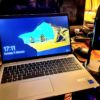Studying spiders has inspired researchers to construct a new generation of 3D photodetectors for use with biomedical imaging. Central to the design are some innovative architectural features drawn from spider webs.
According to lead researcher Chi Hwan Lee: “We employed the unique fractal design of a spider web for the development of deformable and reliable electronics that can seamlessly interface with any 3D curvilinear surface.”
This led to developing a dome-shaped, photodetector array that can detect both direction and intensity of incident light at the same time. This was based on 3D optoelectronic architectures, created using models based on the spider web structure and shape. Optoelectronics is concerned with the application of electronic devices that use light, as with the fabrication of LEDs. The innovation provides the basis for building a platform technology that can integrate a fractal web design into electronics and sensors.
The study appears in the journal Advanced Materials, with the research paper headed “Fractal Web Design of a Hemispherical Photodetector Array with Organic‐Dye‐Sensitized Graphene Hybrid Composites.”
In related news, Swiss scientists have been studying spiders in space. This is to assess the influence of gravity to their web-building. The important insight is that light plays a significant role in shaping arachnid orientation.
The following video explains the basis of the experiment:
It might be thought that the spider we building process was based on gravitational forces, however the role of photodetection should not be underestimated. In essence, University of Basel scientists state, the research showed how spiders use light as an additional orientation aid when gravity is absent.
The study appears in the journal The Science of Nature, with the study paper titled “Spiders in space—orb-web-related behaviour in zero gravity”.













